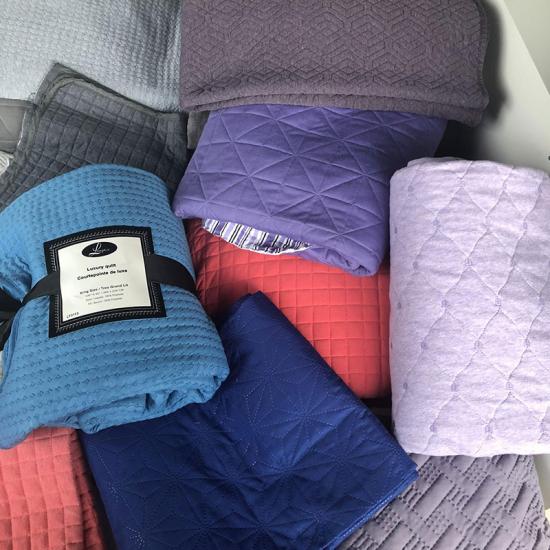Microfiber ultrasonic quilts are significantly different from ordinary quilts in many aspects. The following is a detailed comparison in terms of materials, production process, performance characteristics, and usage experience:
Material and structure
Microfiber ultrasonic quilt: Ultrafine fibers are used as filling or fabric materials. The diameter of this fiber is much smaller than that of traditional fibers, and it has a more delicate touch and a higher specific surface area. Ultrafine fibers are treated with ultrasonic technology, which may further enhance the bonding between fibers or improve the overall performance of the fabric.
Ordinary quilts: Cotton, polyester, down, silk and other materials are usually used as filling or fabric. The fiber diameter of these materials is relatively thick, and the touch may not be as delicate as ultrafine fibers.
Production process
Microfiber ultrasonic quilt: During the production process, ultrasonic technology is used for fiber processing or fabric weaving, which may promote fiber bonding, improve fabric fluffiness or improve fabric breathability through high-frequency vibration. This technology helps to improve the overall performance and comfort of the quilt.
Ordinary quilt: The production process is relatively traditional, and conventional process flows such as spinning, weaving, and filling may be used. Although there are certain differences in the production process of quilts made of different materials, they are generally not as innovative as the production process of microfiber ultrasonic quilts.

Performance characteristics
Softness and touch: Microfiber quilts are very soft to the touch due to their small fiber diameter, giving people a skin-friendly and comfortable feeling. The softness and touch of ordinary quilts depend on their materials and craftsmanship.
Breathability and warmth retention: There are many tiny pores between the fibers of microfiber quilts, which help promote air flow and improve the breathability of the quilt. At the same time, microfiber quilts also have good warmth retention properties. The breathability and warmth retention of ordinary quilts vary depending on the material, but overall they may not be as balanced as microfiber quilts.
Cleaning and antibacterial: Microfiber quilts have strong adsorption capacity and can absorb dust, particles and liquids that are many times their own weight, so they are easier to keep clean. At the same time, some microfiber quilts also have health functions such as antibacterial and anti-mite. Ordinary quilts may be relatively weak in cleaning and antibacterial.
User experience
Lightness and comfort: Microfiber quilts are usually lighter, and because of their fine fibers and soft touch, they can bring better comfort during use. The lightness and comfort of ordinary quilts vary depending on the material and weight.
Applicable scenarios: Microfiber quilts are suitable for a variety of scenarios and climatic conditions due to their unique performance characteristics. Whether in cold winter or warm summer, they can provide good warmth and comfort. Ordinary quilts may need to be replaced according to different seasons and climatic conditions.
There are significant differences between microfiber ultrasonic quilts and ordinary quilts in terms of materials, production processes, performance characteristics, and user experience. Microfiber quilts have gradually become one of the most popular products on the market with their delicate touch, good breathability and warmth retention, easy cleaning, and antibacterial performance characteristics.















.jpg?imageView2/2/format/jp2)
.jpg?imageView2/2/format/jp2)
.jpg?imageView2/2/format/jp2)
.jpg?imageView2/2/format/jp2)
.jpg?imageView2/2/format/jp2)
.jpg?imageView2/2/format/jp2)
.jpg?imageView2/2/format/jp2)

.jpg?imageView2/2/format/jp2)